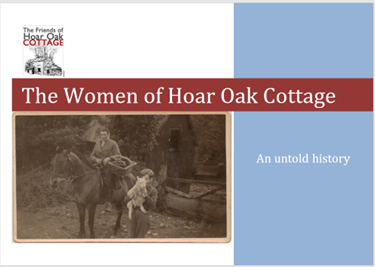The idea of big families – called ‘long families’ in old dialect – is often considered a characteristic of rural families in the 18th and 19th centuries including those who lived and worked at Hoar Oak Cottage. We at The Friends had fallen into that trap of thinking Hoar Oak Cottage must have been positively crammed with adults and children and indeed, as such a small cottage, it may well have seemed it at times. However, during research for our book The Women of Hoar Oak Cottage: An Untold History, a better understanding of not only family sizes but the lives and deaths of children emerged. There were indeed some big families, but that’s not the entire story.
Starting with the first child known to be born at Hoar Oak in 1819, we summarise the findings below linked to their mothers’ names and ending with the last family the Antells in the 1950s:
- Elisabeth Vellacott nee Passmore: 2 children at Hoar Oak followed by 7 elsewhere. 2 died.
- Maria Dovell nee Pile: 1 child at Hoar Oak Cottage followed by 4 elsewhere. 2 died.
- Elizabeth Richards nee Rawle: 1 son followed by 3 at Hoar Oak Cottage.
- Mary Saunders nee Lancey: 1 child at Hoar Oak Cottage. 4 elsewhere. 2 died.
- Mary Bale nee Brook: 1 daughter. Both mother and daughter died at Hoar Oak Cottage.
- Betsy Moule nee Berry: 6 children, only 1 born at Hoar Oak and two of whom died young.
- Agnes Vellacott nee Crocombe: 5 children, 2 born at Hoar Oak. All survived to adulthood.
- Fanny Davidson nee Littlewood: 4 children at Hoar Oak Cottage, 2 more at Winstitchen.
- Helen Renwick nee Rodgers: 3 children, all at Hoar Oak, one of whom died in infancy.
- Sarah Johnstone nee Thomason: 13 children, 10 at Hoar Oak Cottage, all survived to adulthood.
- Christina Jackson nee Michell: 1 son and 1 daughter born at Hoar Oak Cottage. Both survived to adulthood.
- Florrie Bass nee Squires: 5 children, 1 at Hoar Oak Cottage, 3 died in Lynton Hospital from the effects of tainted milk.
- Alice Hobbs nee Jones: 1 child at Hoar Oak Cottage.
- Dorothy Little nee Jones: 4 children, 3 at Hoar Oak Cottage.
- Gertie Antell nee Ridd: 2 children, neither at Hoar Oak, 1 died aged 12 in Bideford Hospital.
Clearly, the number of children in Hoar Oak families shrunk from Elizabeth Vellacott nee Passmore and her 9 children to Gertie Antell nee Ridd’s two children. The big family of 13 Johnstone children seems to have been a ‘blip’ rather than the ‘norm’. These records also show the sad fact that many Hoar Oak families lost at least one, if not two children in infancy or youth, with the most startling loss being the three Bass children who died due to drinking ‘tainted’ (unpasteurised) milk. In the case of Hoar Oak Cottage, it is safe to say that the idea of ‘big’ families was a bit of a myth and infant mortality meant there were rarely as many children at any one time as we might think.

You can purchase a copy of The Women of Hoar Oak Cottage: An Untold Story by contacting info@hoaroakcottage.org Cost is £5.95 + P&P.
